Despite wishing we could stay in bed for a while longer after our restless night, we knew we had to get up on schedule Monday morning to see everything we wanted to see that day. The continental breakfast provided at Hôtel Les Montois was just adequate: baguettes and croissants with lukewarm “hot” chocolate from a self-serve machine. Michael and Pat took a few bites of their pains au chocolat but didn’t finish them because they tasted day-old—but when we considered that Frédéric and his wife were running this place by themselves, we were inclined to cut them some slack. We hope other guests also will be patient as the young couple tries to make a go of the hospitality business.
One of the main reasons for choosing to drive through Normandy this week was so that we could take Pat to visit the cemeteries along the coast where thousands who died in the D-Day invasion of 1944 are buried. Michael and Pat’s father was a career officer in the U.S. Navy, but did not participate in the invasion because it began the day before he graduated from the Naval Academy in Annapolis. He spent the remainder of World War II learning to become a pilot, taking off from and landing on the Navy’s aircraft carriers. Later, during the Cold War, he would fly reconnaissance missions over the Soviet Union. In 1961, he would lose his life while piloting a test plane off the coast of Florida. So the Harward family has deep respect for those who have served in the military, willing to put their own lives in jeopardy to preserve freedom.
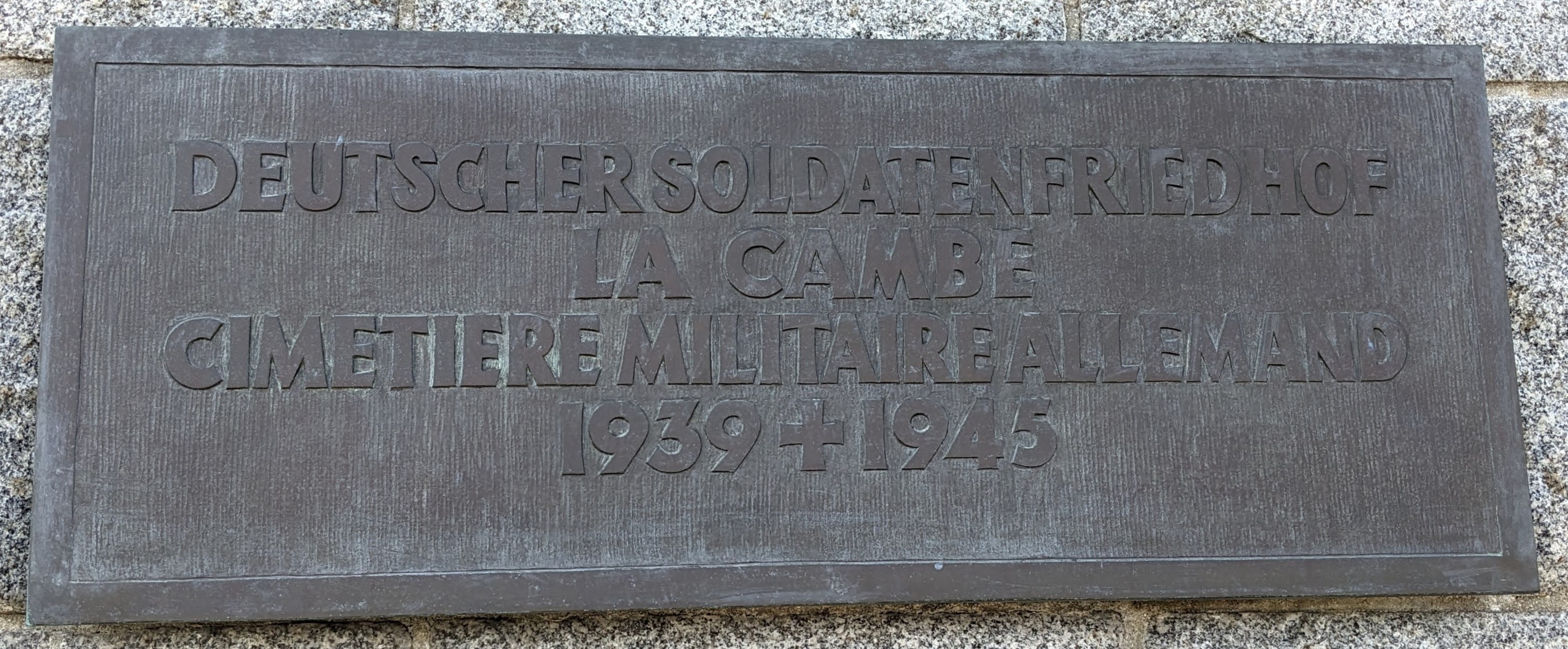
La Cambe is where German soldiers who died in Normandy are buried
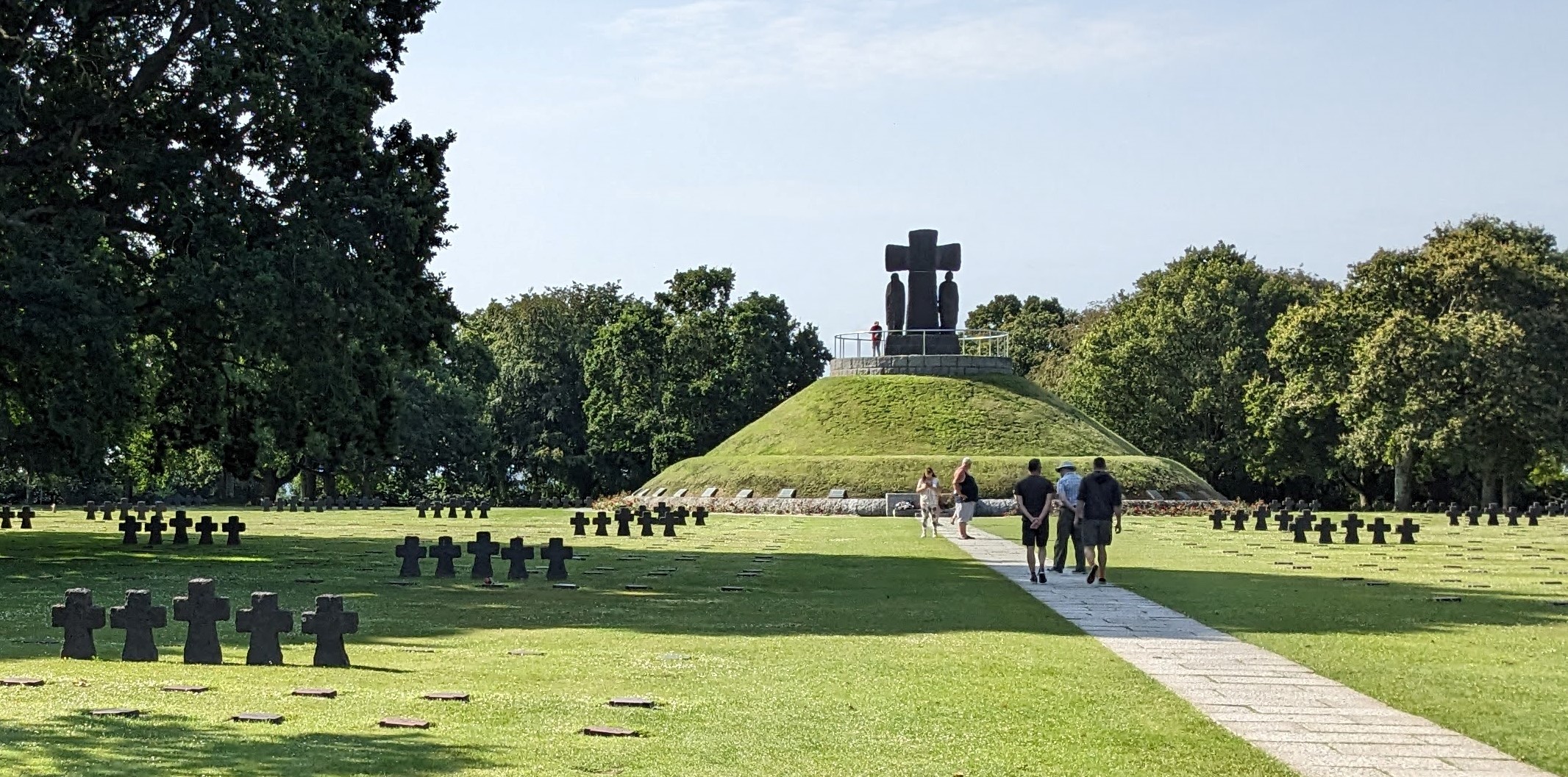
German graves in La Cambe
The first cemetery at which we paid our respects was La Cambe, where more than 21,000 German soldiers who died in France during the war are buried. A couple of people had told us that the German cemetery had a ”dark” feeling about it, as if honoring “enemy” soldiers was somehow akin to condoning evil, but the only darkness we noticed was in the stone used for the grave markers. On the contrary, we felt moved and uplifted by a statement on a sign at the entrance that declared in French, English, and German: “[This] is a graveyard for soldiers not all of whom had chosen either the cause or the fight. They too have found rest in our soil of France.”
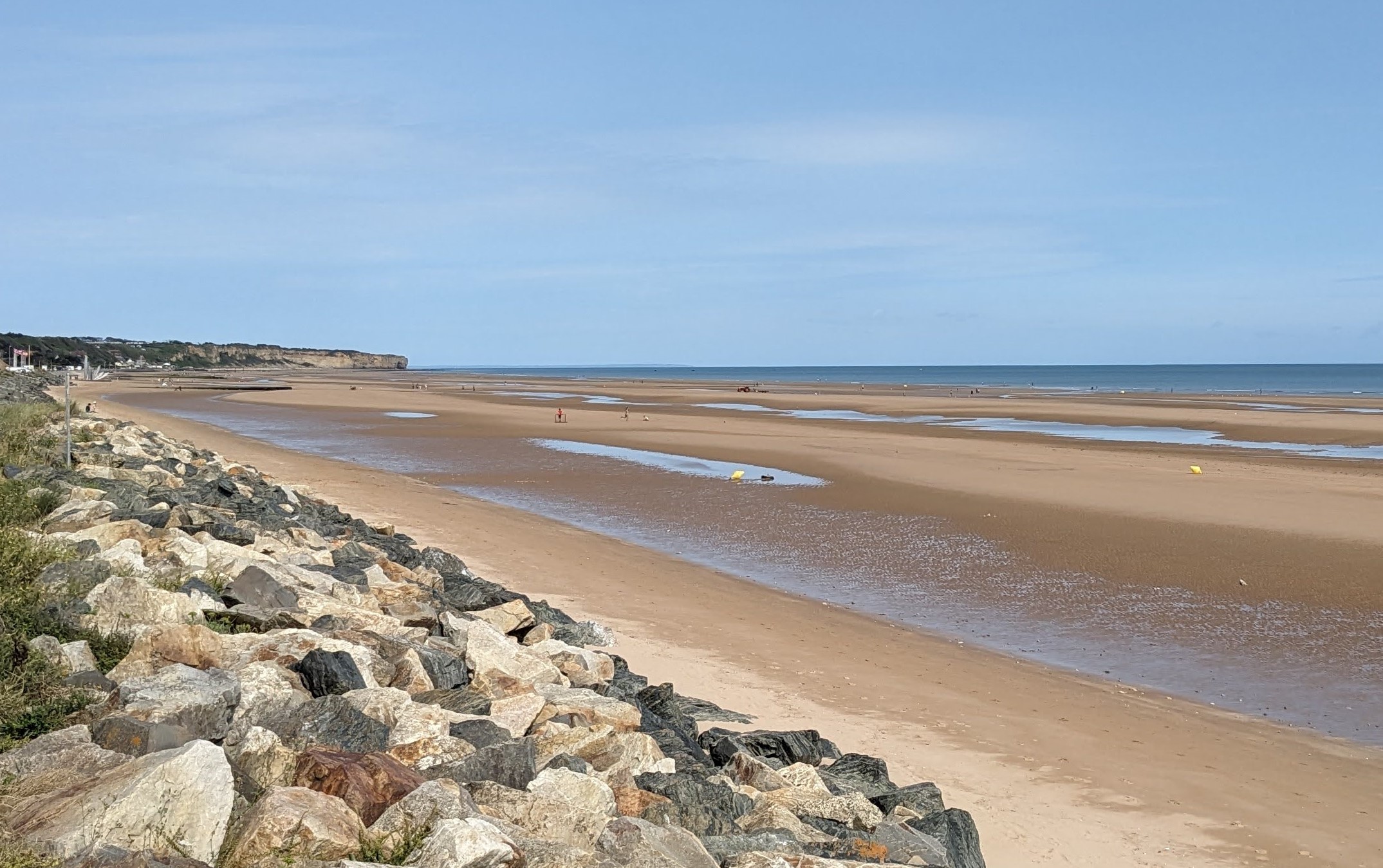
Omaha Beach
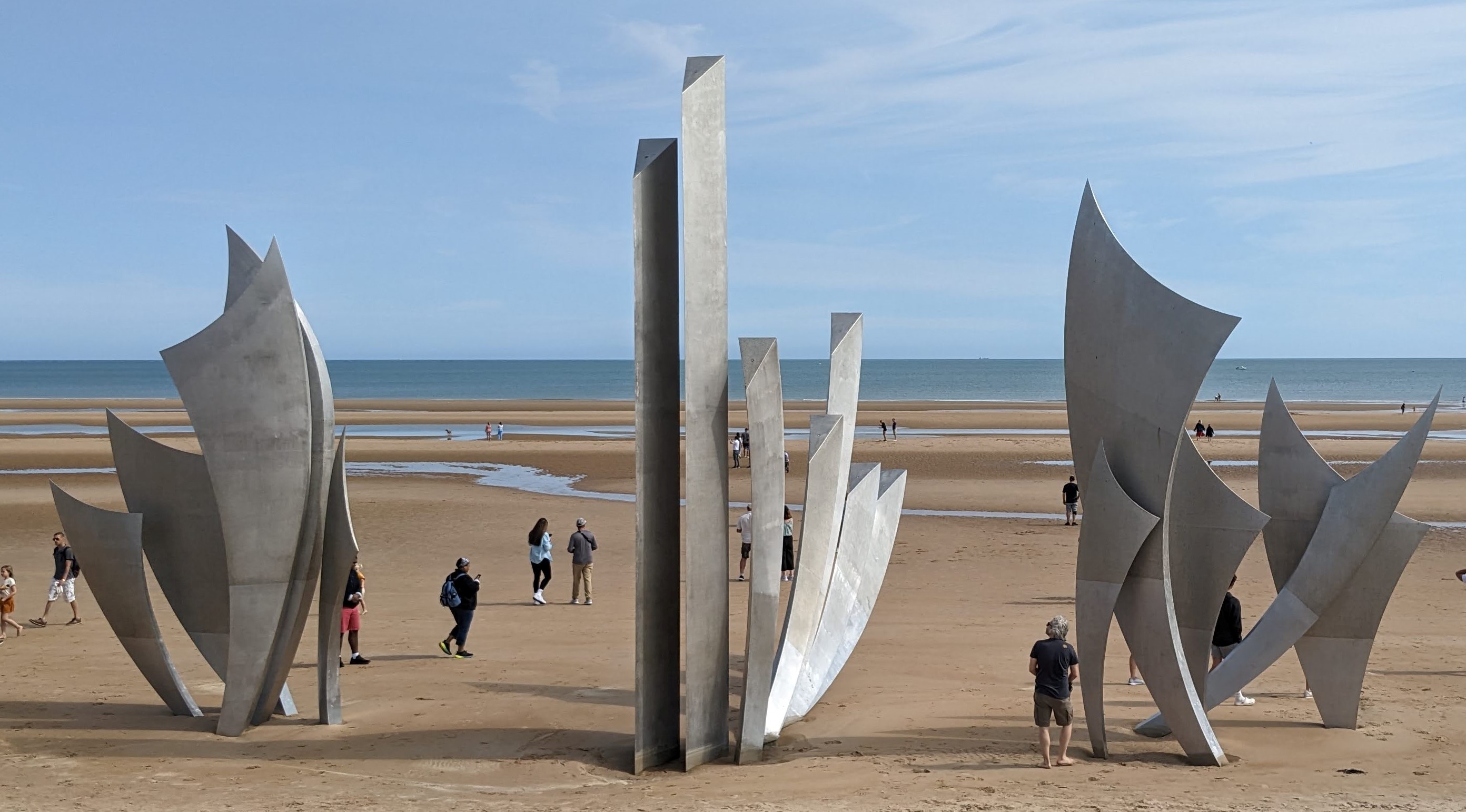
Sculpture commemorating “Les Braves”
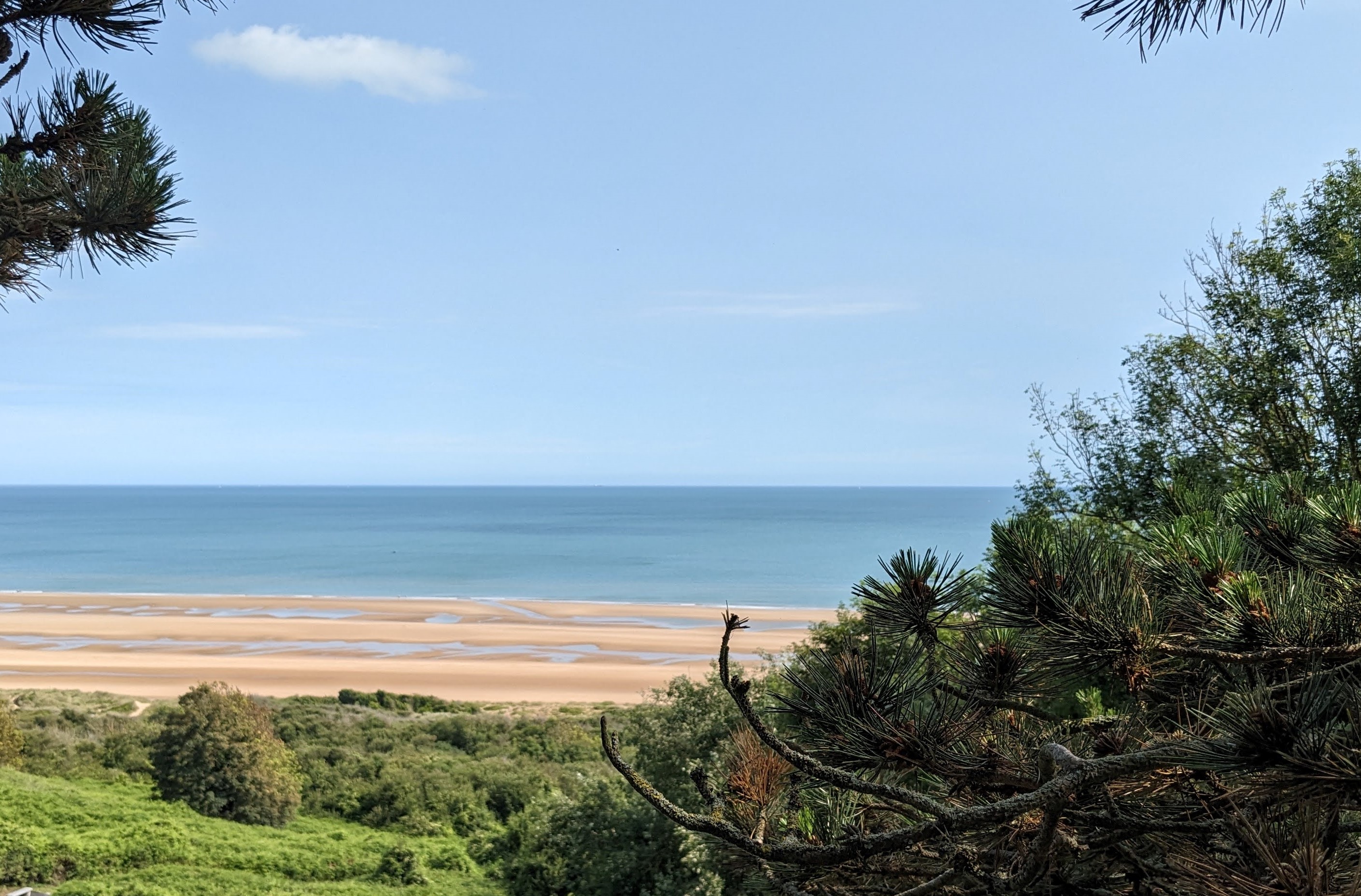
View of Omaha Beach from the American Cemetery
The theme of unity, peace, and forgiveness was evident at our next stop as well. The weather was sunny and the water serene at Omaha Beach, nothing like the miserable, wet day we’ve seen depicted in movies such as Saving Private Ryan and Dunkirk. The steep cliffs that seem to figure so prominently in such depictions were so far to the west that we could hardly see them, so the focus of our visit became the memorial monument erected on the level sand where transport ships disgorged thousands of Allied soldiers on D-Day. Anilore Banon, the French sculptor who created Les Braves, explained that the monument’s three groupings represent Wings of Hope, The Rise of Freedom, and Wings of Brotherhood.
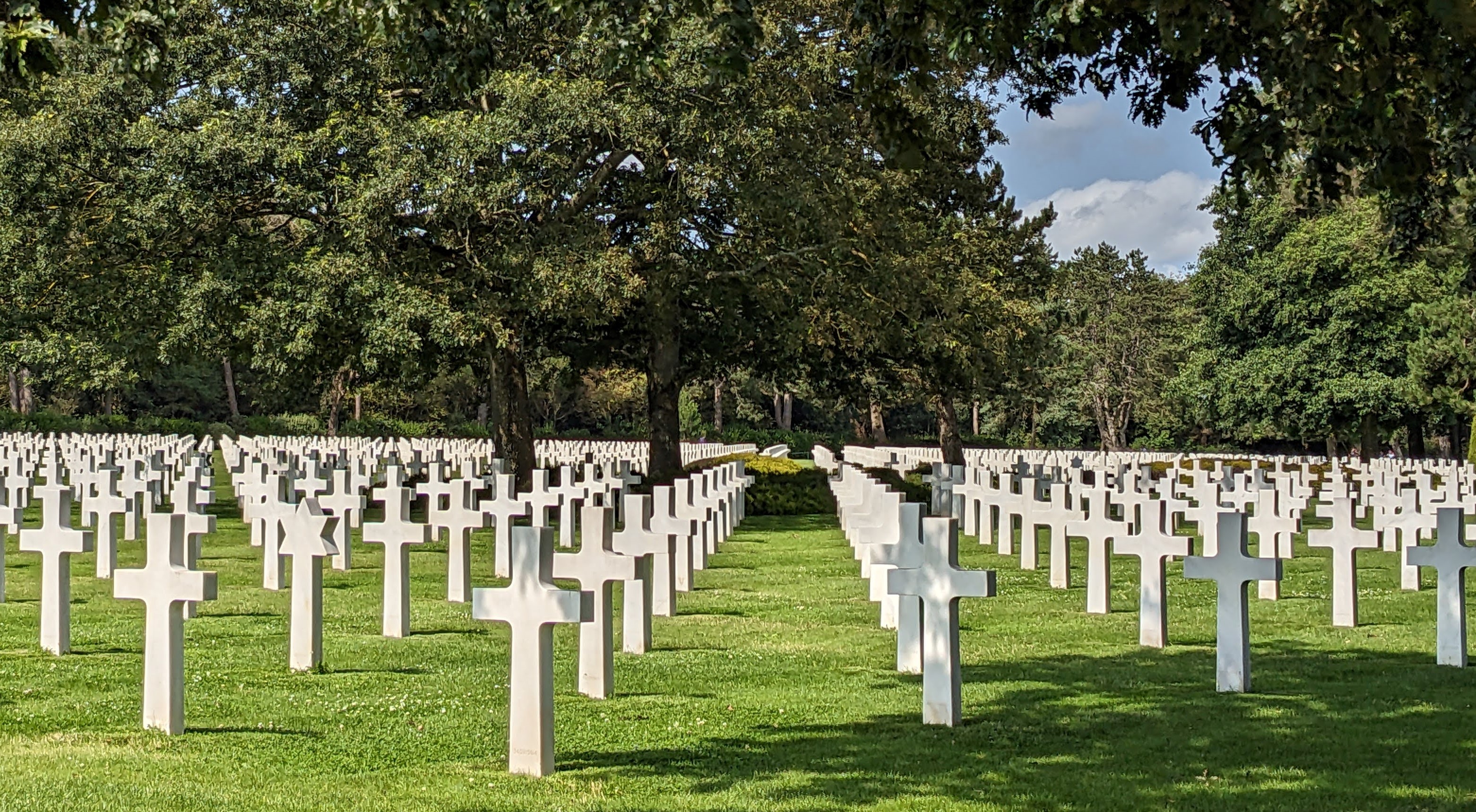
One section of the vast American Cemetery
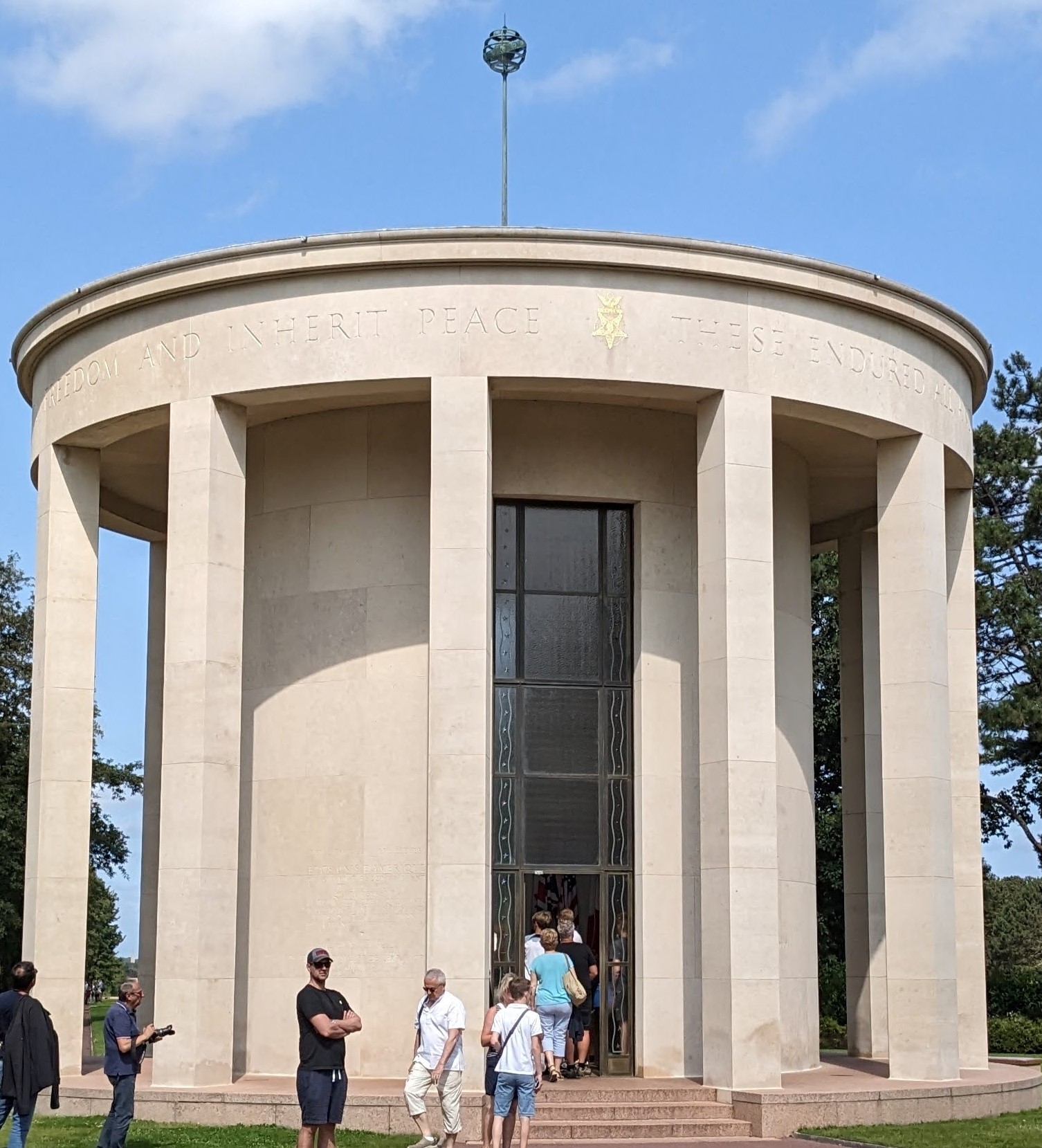
Memorial Chapel at the American Cemetery
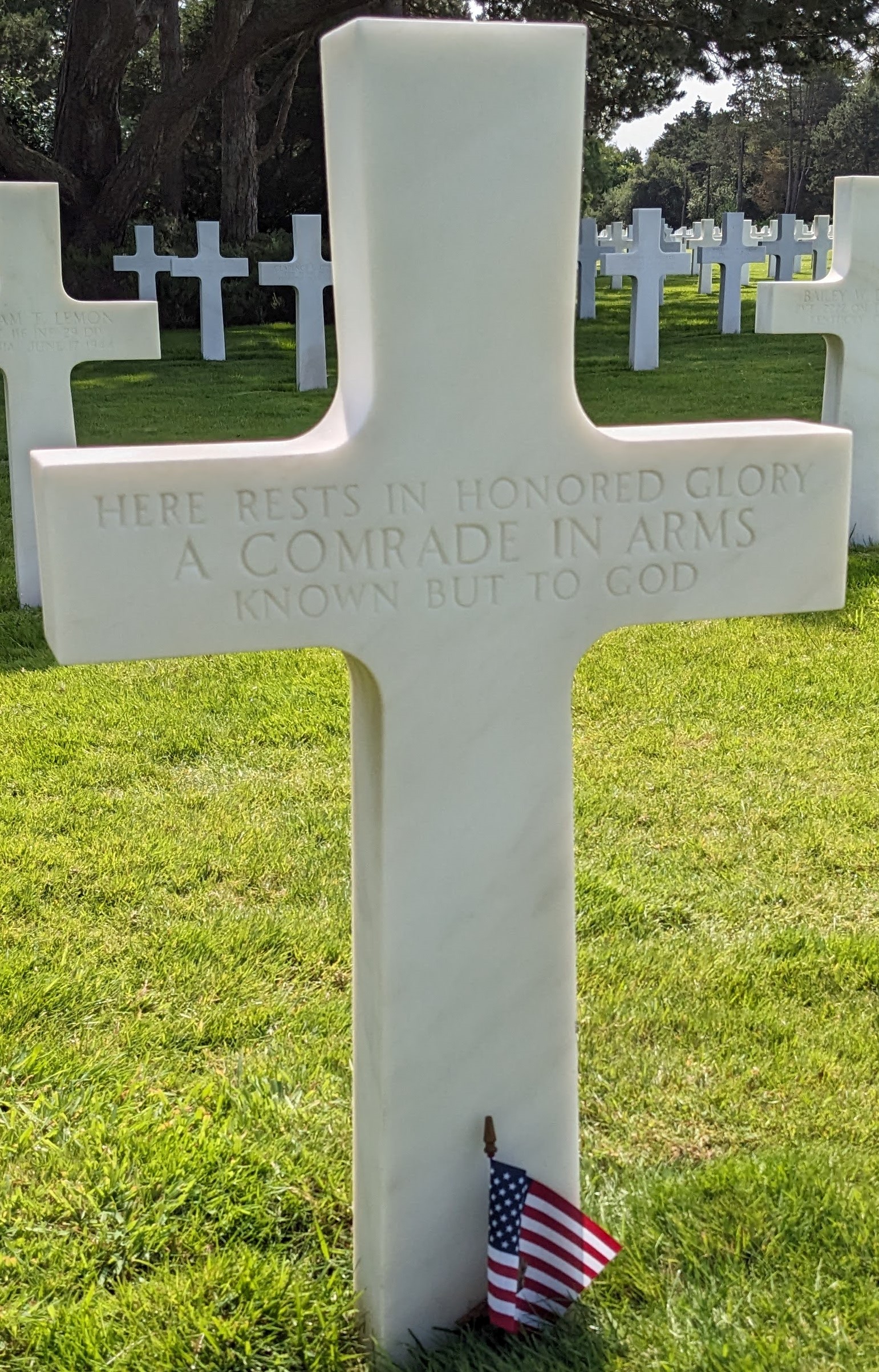
Even the unknown were honored
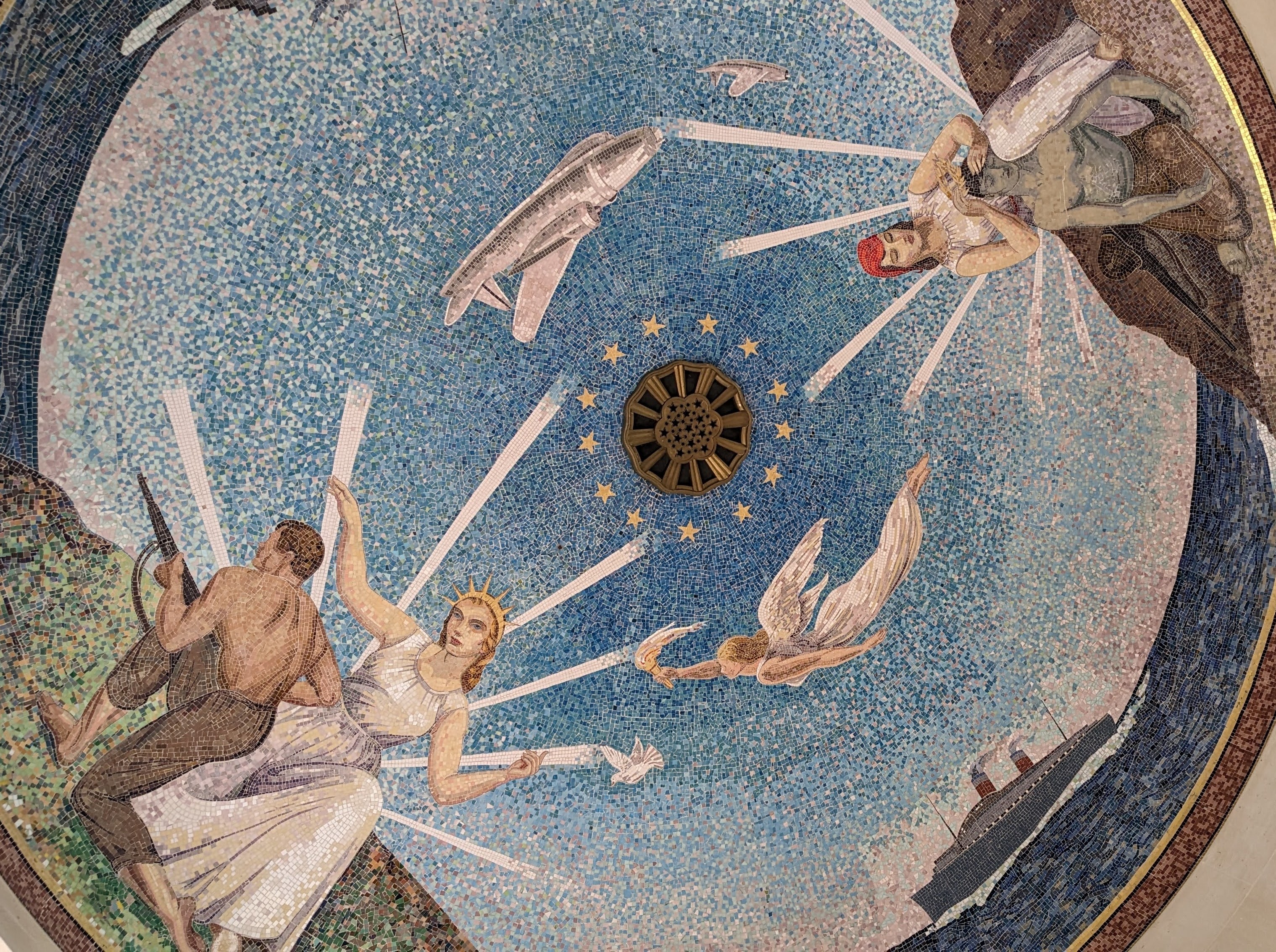
Mosaic on the ceiling of the Memorial Chapel
Next came the American Cemetery. Forty-five years ago, when we first visited the site, both of us were overcome by the sorrowful majesty of the place. This time, we were no less moved. The immaculate grounds with their unending rows of perfectly aligned white crosses—or, occasionally, a Star of David—overwhelmed us, but it was even more difficult to read some of the names of individuals engraved on those markers. Most poignant were the ones marked: “A comrade in arms, known but to God.”
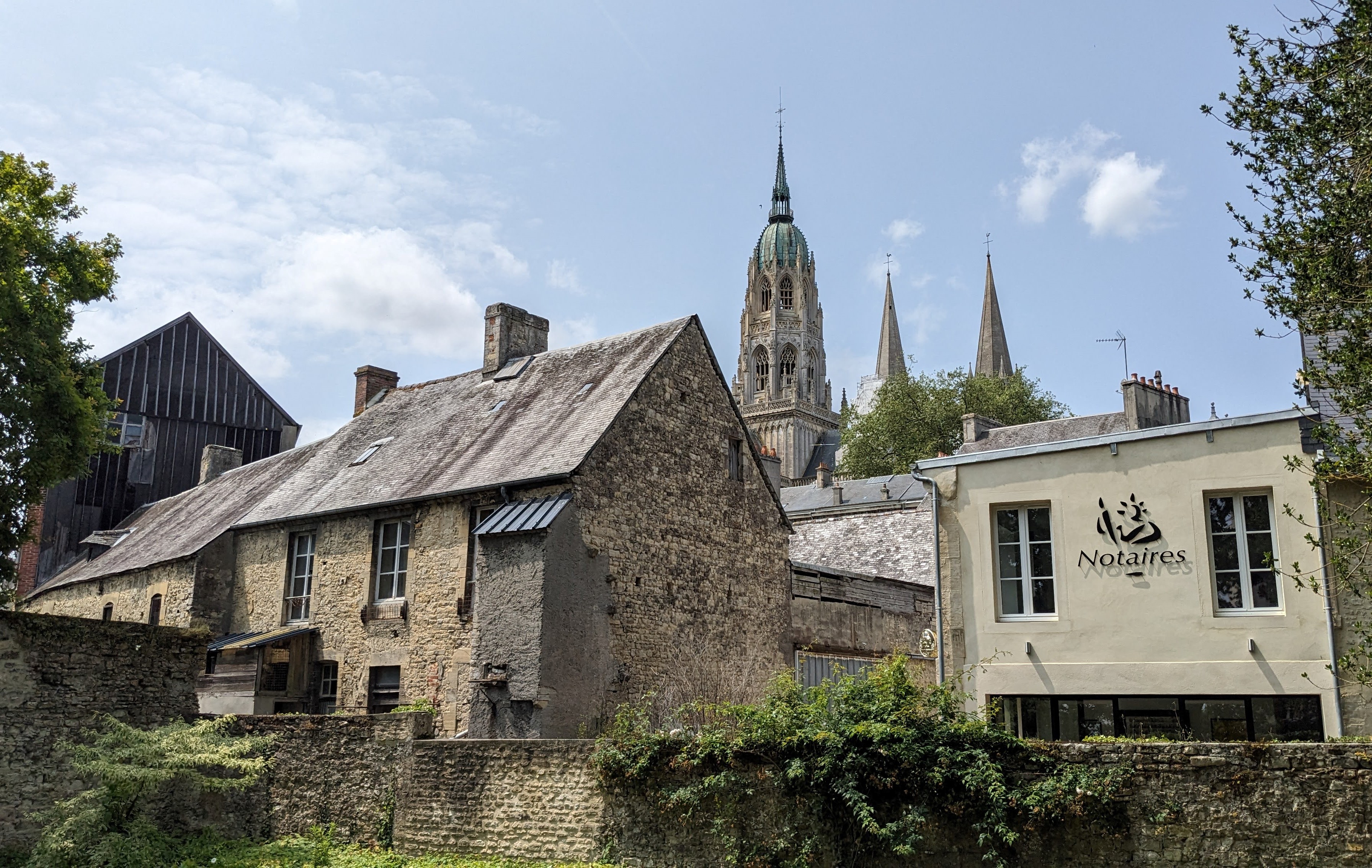
Bayeux
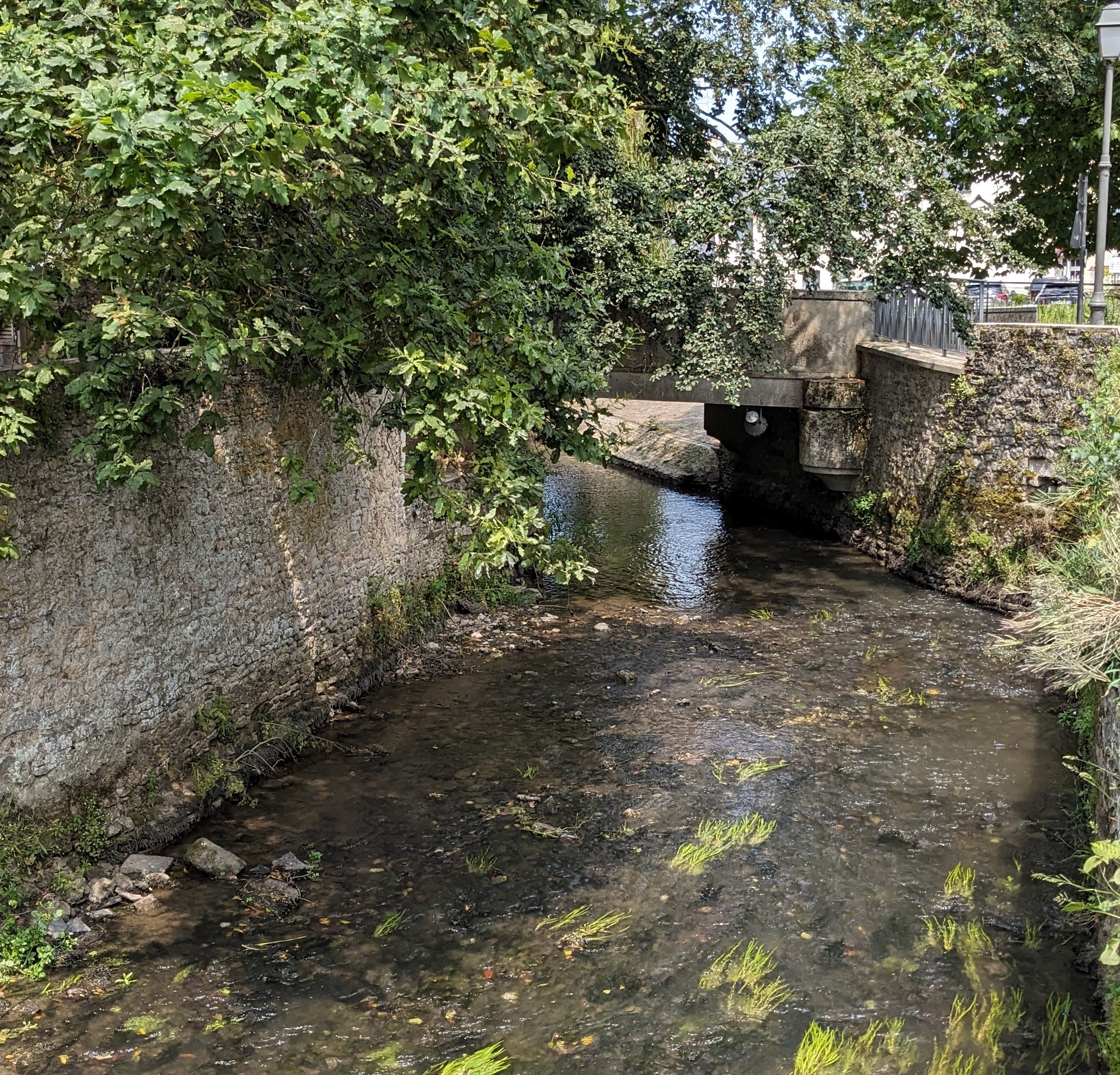
The women of Bayeux used to do their laundry near this spot in the Aure River
In a somber and contemplative mood, we drove about 15 miles to Bayeux, where the mood quickly changed to one of mild frustration as we searched for a parking space in a small town bustling with tourists. Fortunately, we spotted someone backing out just as we were about to exit an at-capacity carpark. Our next challenge was finding the museum where Bayeux’s famous tapestry is displayed, using a GPS system that was not doing a good job keeping up with us—even at walking speed. Eventually, we found the museum and purchased tickets, but decided to get lunch before going inside to see the tapestry.
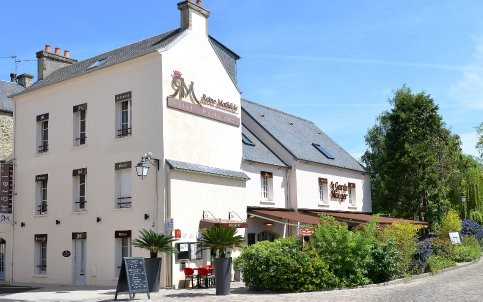
Le Garde Manger restaurant is at the back of a hotel
We settled for the convenient: La Garde Manger (The Pantry) was nearby and had a four-out-of-five Google rating, but we could see right away that the menu was kind of the French equivalent of Applebee’s, catering to undiscriminating Americans. Nancy had a bowl of French onion soup that was just meh; Michael’s green salad with potatoes, bacon, and croutons spread with goat cheese wasn’t bad, but not worth a photo.
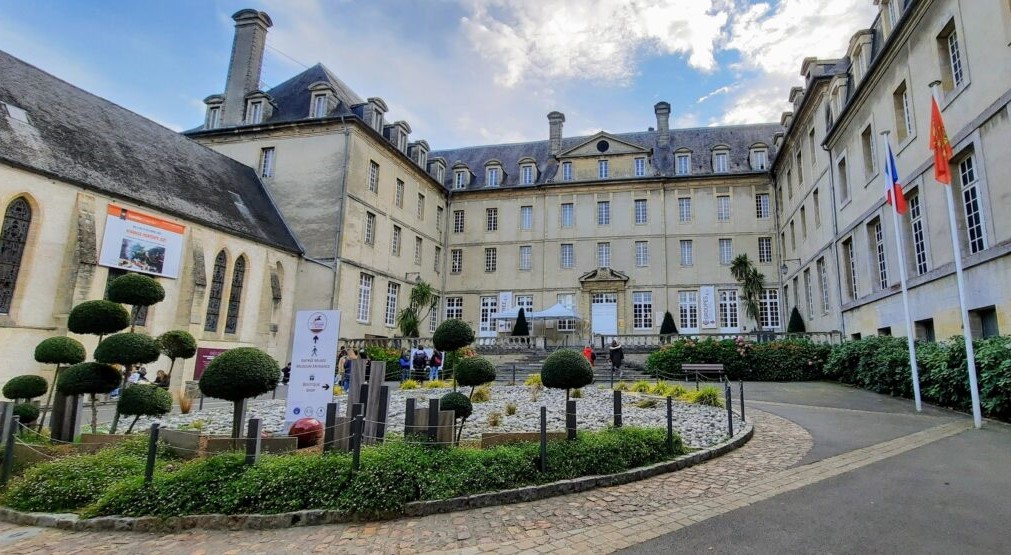
Musée de la Tapisserie de Bayeux
In contrast, the Bayeux Tapestry was definitely photo-worthy, so we were distressed to learn that photography is strictly forbidden in the museum. (Our photo gallery below is made possible by a generous grant from Wikipedia.) Nancy was glad to see that the historic tapestry is now housed in a facility on a par with that of the Apocalypse Tapestry in Angers, rather than behind cracked Plexiglass panels in the old town hall, as it had been when she first saw it in 1976. In the current display, the tapestry is well-lit, so it’s easy to see all the details, and the audio guide helped us follow the story that the tapestry depicts. In brief: It recounts events surrounding the Battle of Hastings in 1066 between the forces of William, duke of Normandy, and Harold, an Anglo-Saxon earl who had claimed the English throne after childless Edward the Confessor died without publicly designating an heir. William won that battle, which (as we were surprised to learn) lasted less than twelve hours. Harold was killed, causing his army to scatter, and William—known ever after as “The Conqueror”—became the king of England. We were disappointed that Hereward the Wake, a Saxon leader who was one of Michael and Pat’s ancestors, was not named in the tapestry. Written accounts from the period state that Hereward participated in several rebellions against William in the years following the Battle of Hastings, but we can’t be sure whether he was present at that famously decisive one.
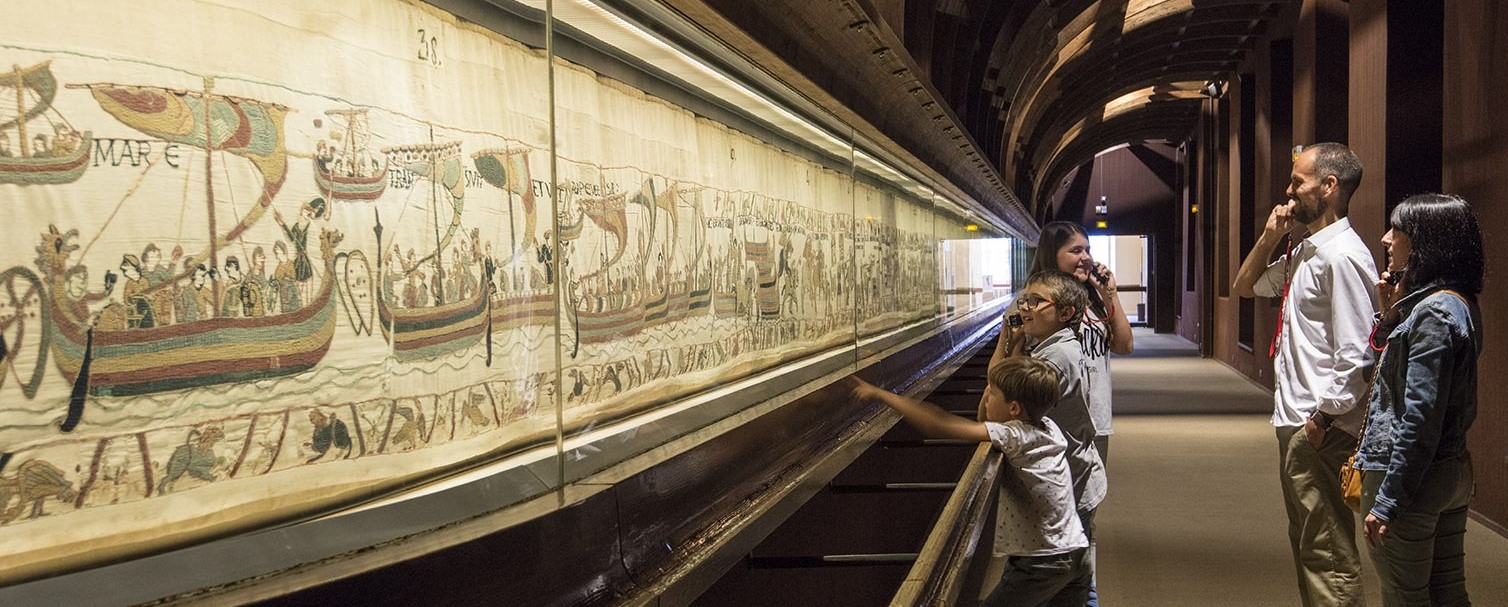
Bayeux Tapestry gallery (Photo from the Normandy Office of Tourism)
The Bayeux Tapestry dates from only a few years after the events it describes, commissioned by Odo, bishop of Bayeux, who was William’s half-brother. Technically, it’s not really a tapestry because the designs are embroidered onto the fabric—a strip of linen 70 meters (230 feet) long—rather than woven into it, as in the Apocalypse Tapestry. In addition to battle scenes depicting soldiers in chainmail falling from their horses and chopping off each others’ heads, the tapestry shows key events that precipitated the battle, as well as preparations such as building ships, stockpiling weapons, and gathering food for the army. Here and there among the embroidered animals, birds, and slain soldiers in the borders are a few unclothed humans who seem to be preparing for copulation. (We’ve noticed that many medieval artists seemed to enjoy slipping prurient details into their work.) It’s astounding to realize that this relatively fragile textile has survived intact for nearly a thousand years, its power to capture the imagination completely undiminished.
Bayeux Tapestry
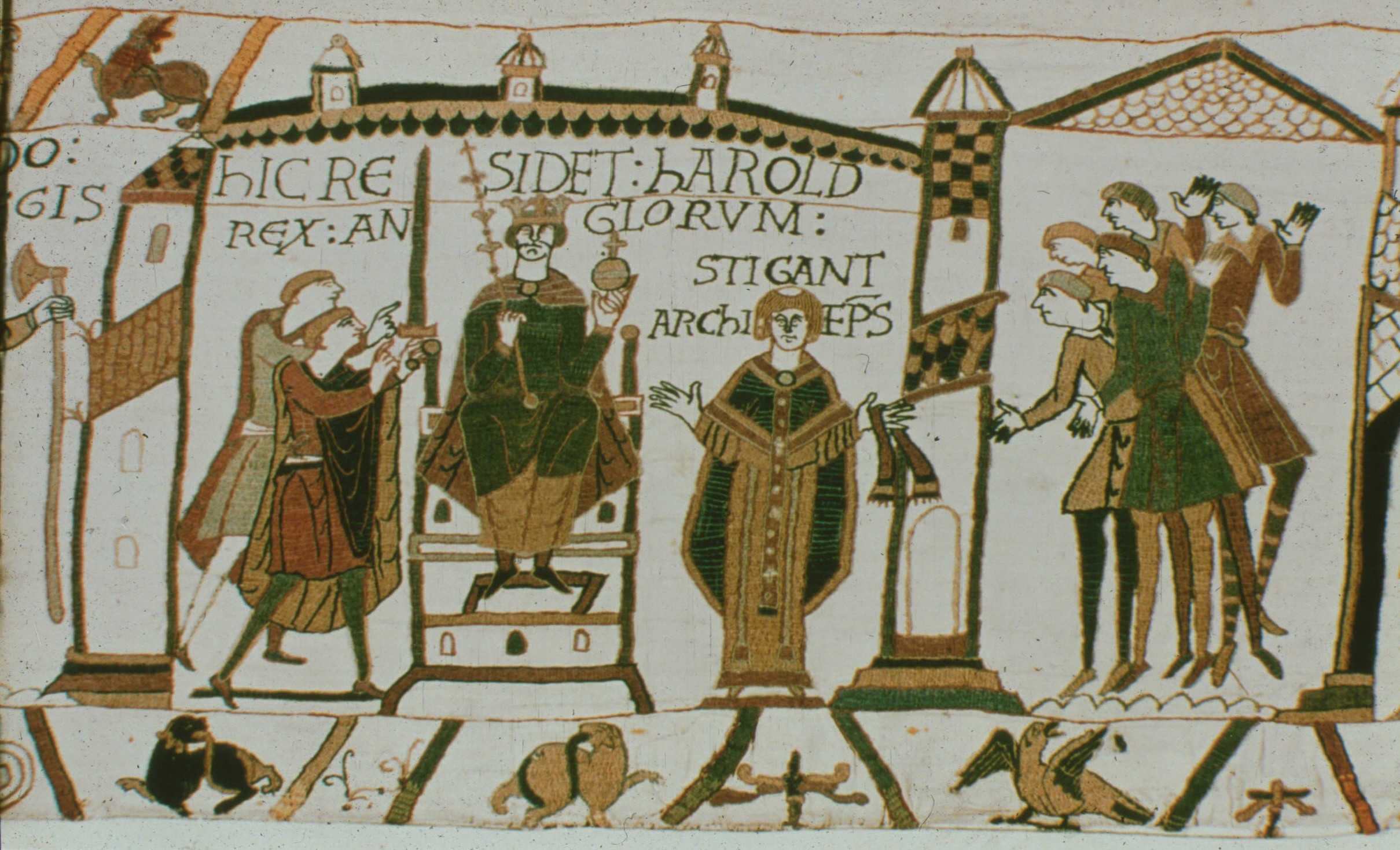 “Here sits Harold, King of the English [and] Archbishop Stigand” |
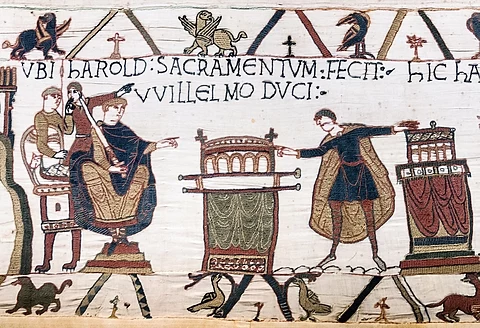 “Where Harold made an oath to Duke William” (Harold allegedly swore to uphold William as the heir to Edward the Confessor, but then reneged) |
 “Here Duke William ordered great ships to be built” |
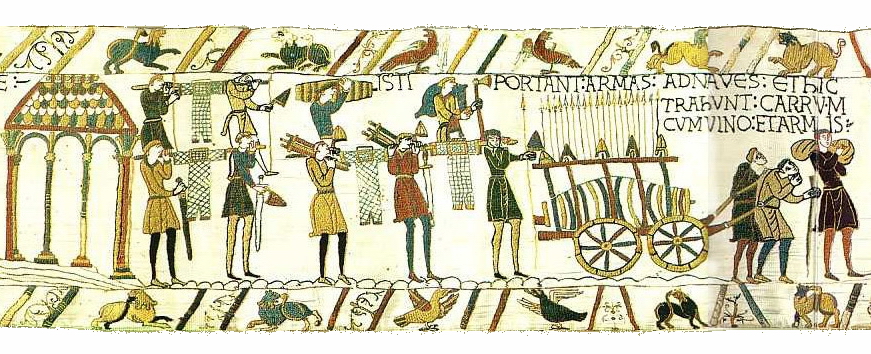 “These men carry arms to the ships and here they drag a cart with wine and arms” |
 “Here Duke William in a great ship crossed the sea and came to Pevensey” (a village on the coast near Hastings) |
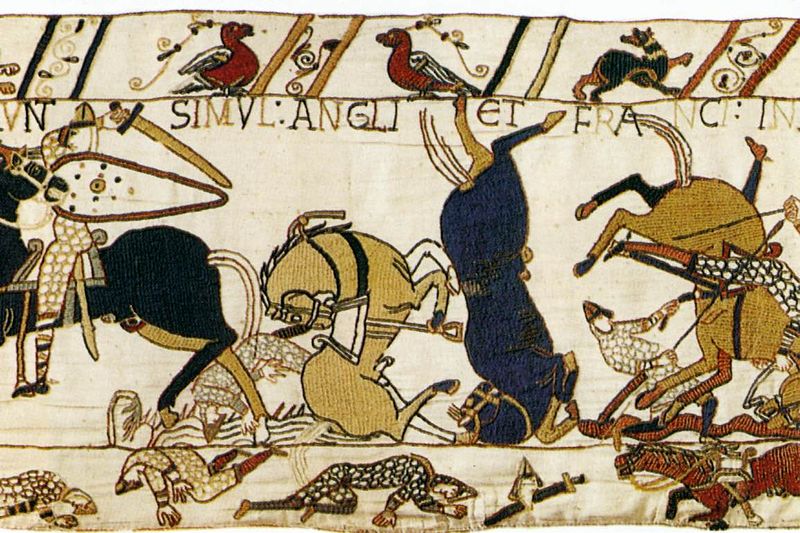 “Here English and French fell at the same time in battle” |
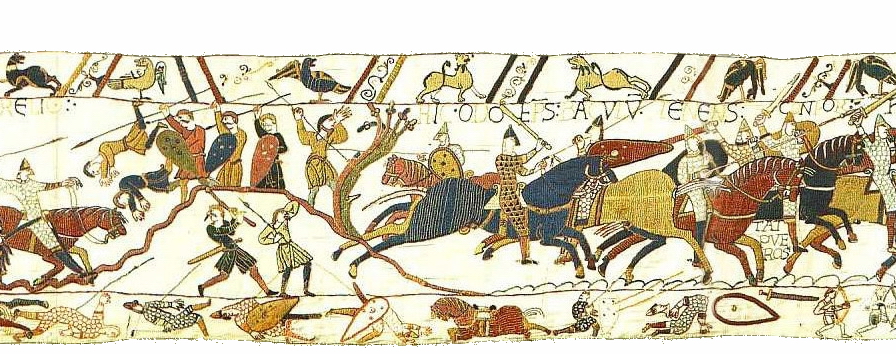 “Here Bishop Odo, holding a club, gives strength to the boys” |
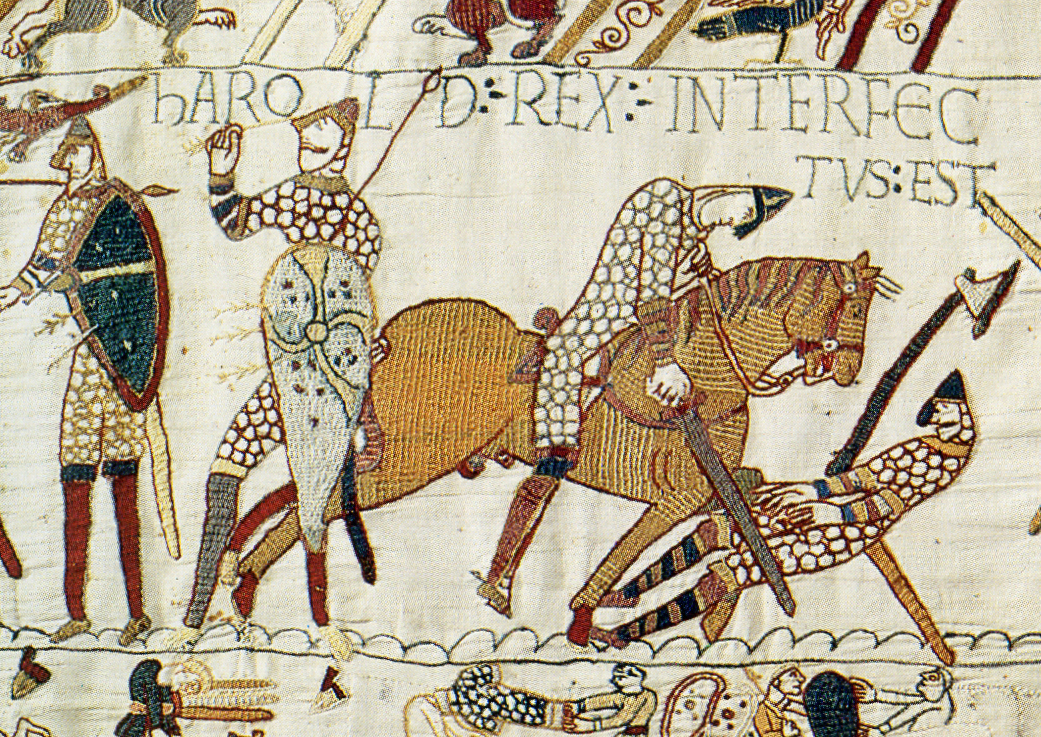 “Here King Harold was slain” |
To view the entire Bayeux Tapestry, click here for the Wikipedia article and then scroll about halfway down the page to an illustration that runs the full width of the page. You can then scroll left to right to see the whole story of the Battle of Hastings unfold in all its glorious medieval detail.
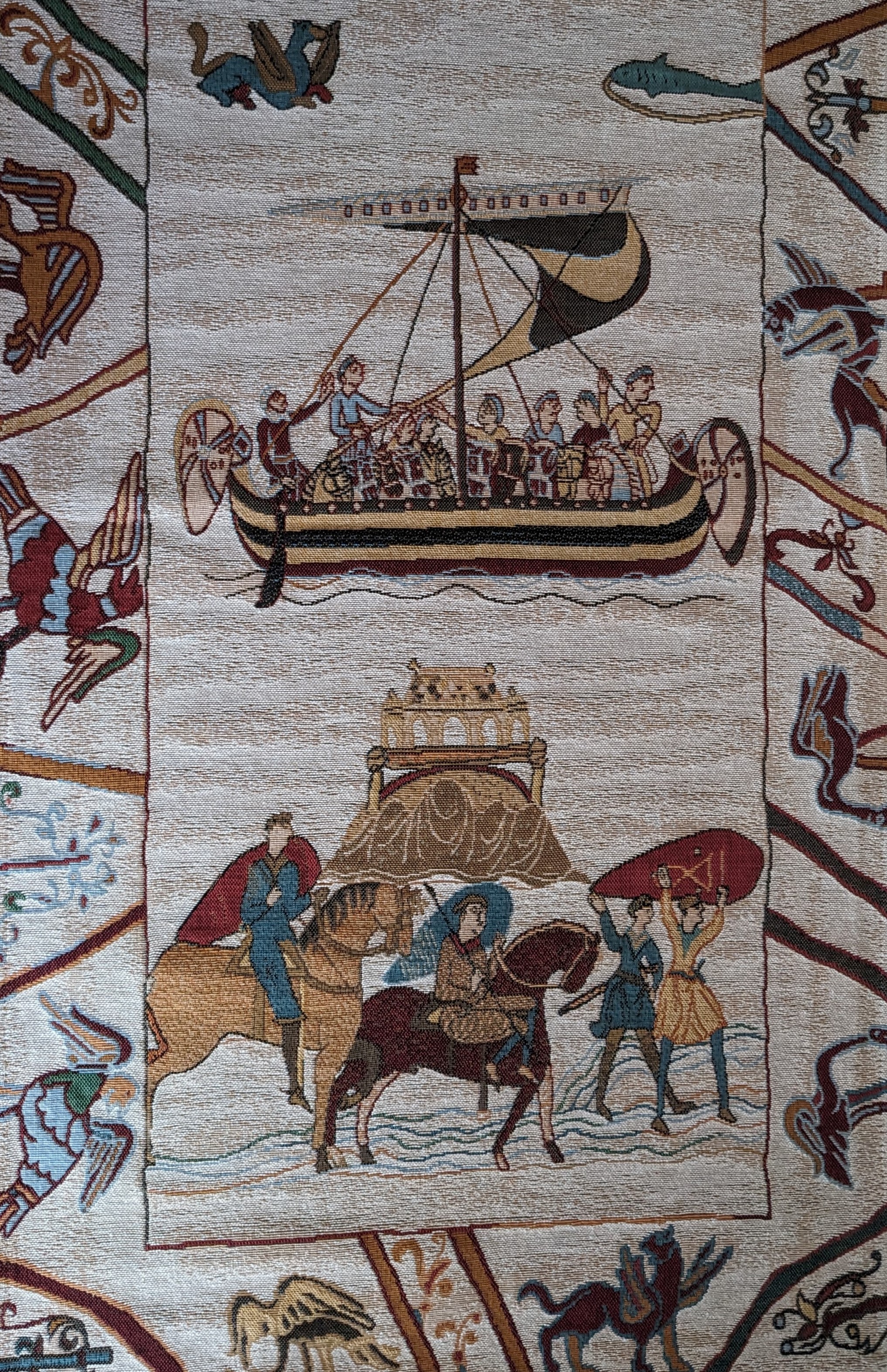
Part of our table runner shows Duke William and Bishop Odo of Normandy with their guardsmen, riding past Mont Saint-Michel on the way to invade England
Exiting through the gift shop (of course), Michael and Nancy succumbed to temptation and purchased a table runner into which are woven copies of some details from the tapestry. Pat left the museum shop before we did because she had promised a friend who had visited Bayeux earlier this year that she would go to another shop located nearby and get a bracelet to match the necklace the friend had bought there.
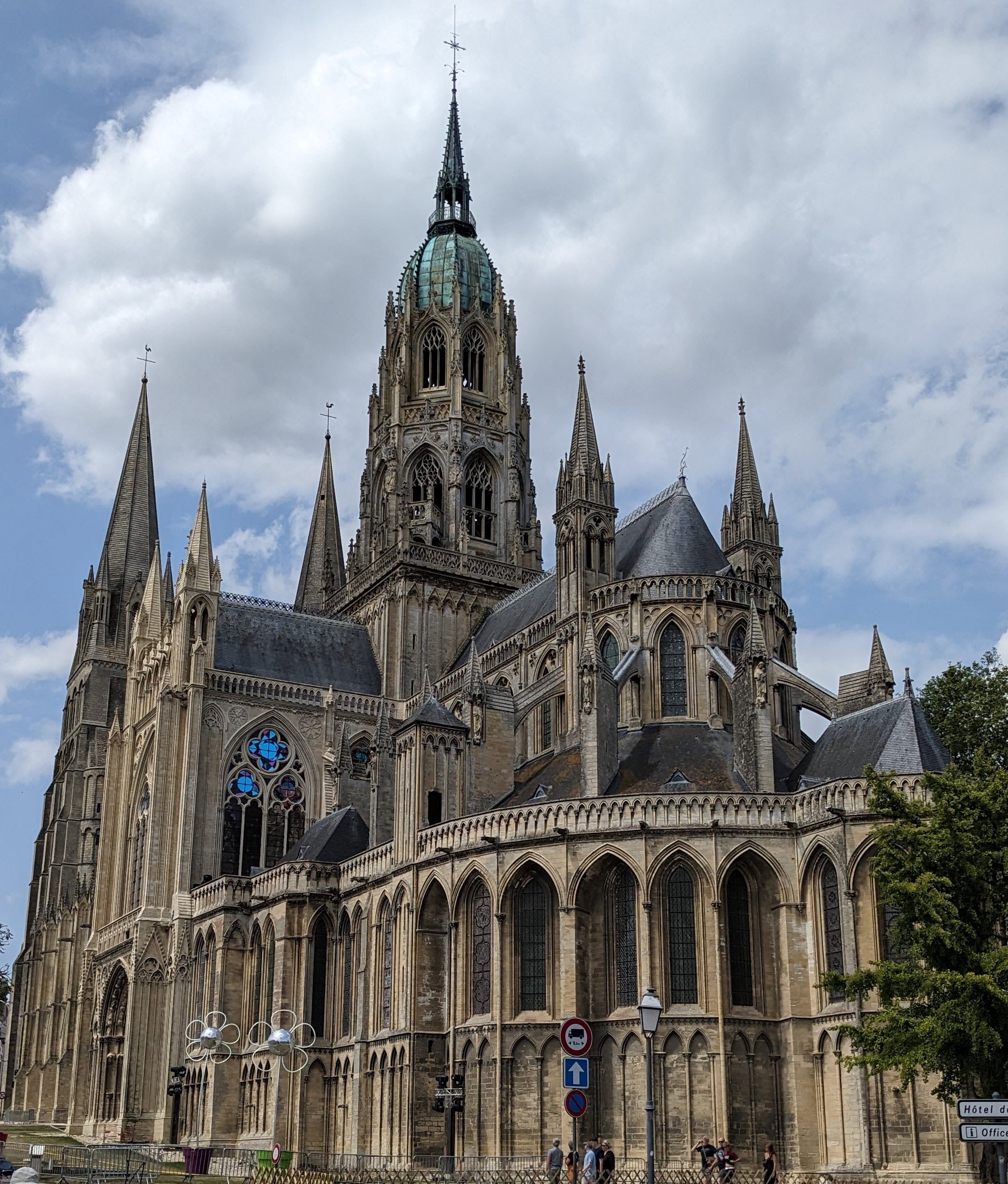
Bayeux Cathedral
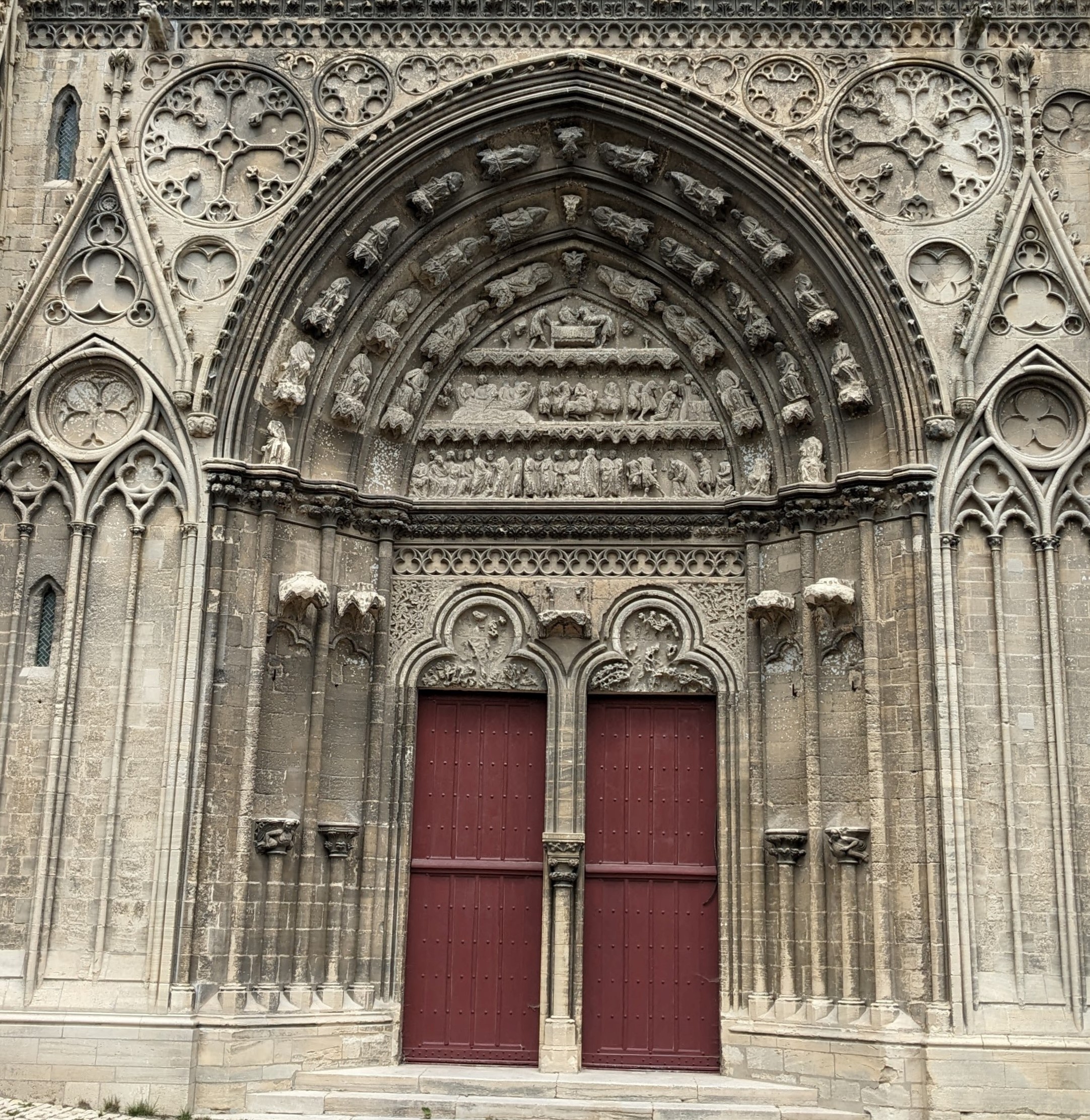
Portal of the Bayeux Cathedral
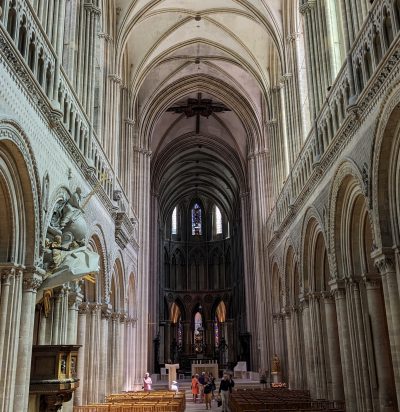
Nave of the Bayeux Cathedral
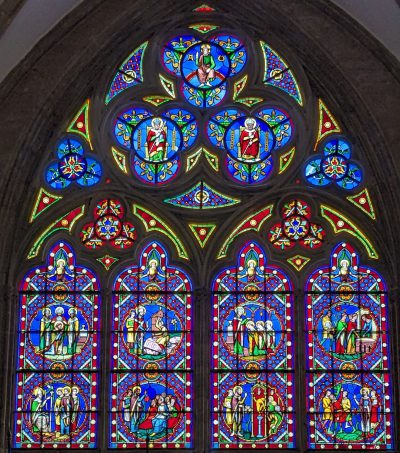
South chapel window, Bayeux Cathedral
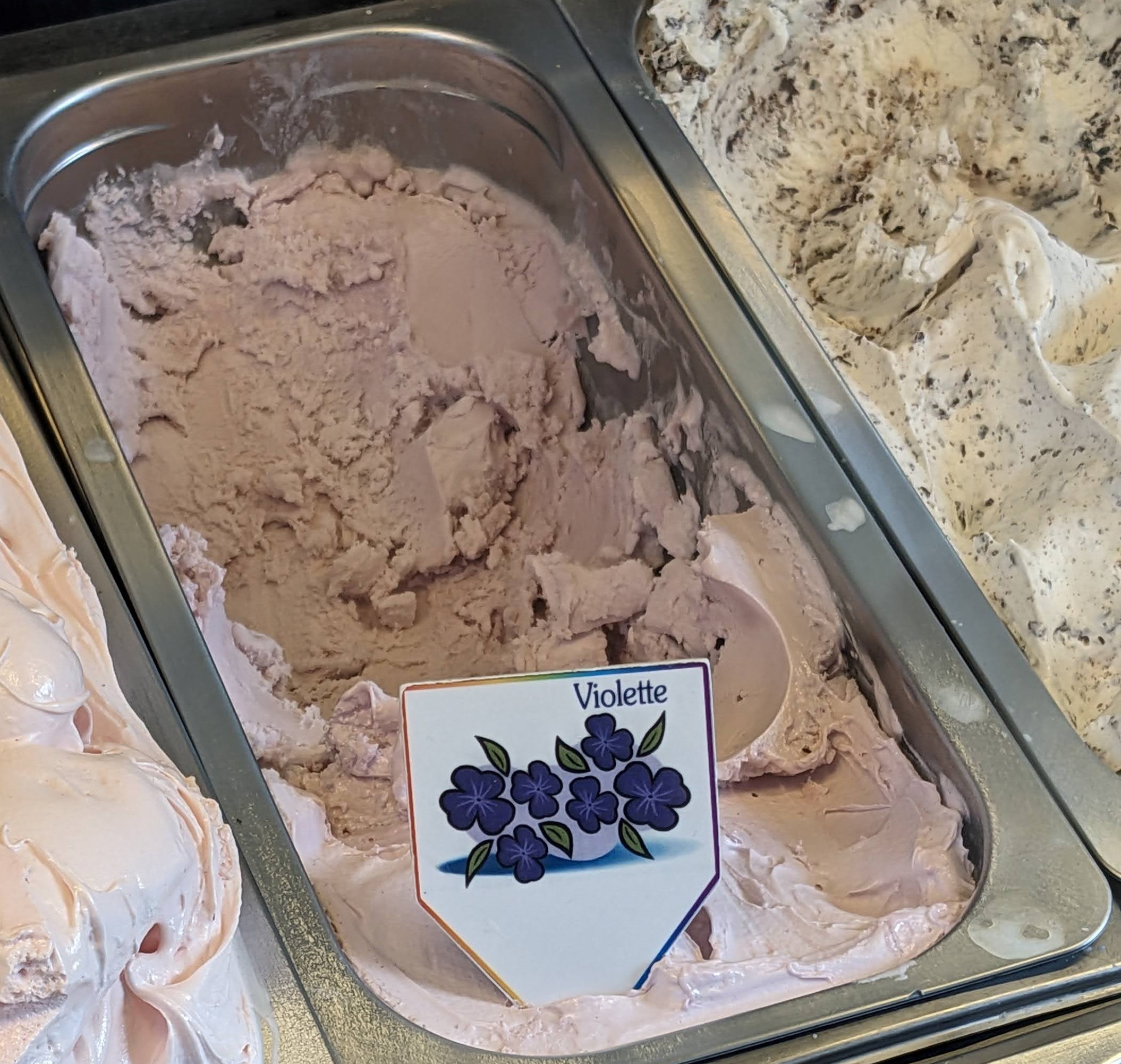
Before leaving Bayeux, we had to get ice cream. Nancy was delighted to find violette in the freezer case, but Michael and Pat chose more traditional flavors
While Pat was carrying out her mission, Michael and Nancy walked up the street to visit the beautiful Cathédral Notre-Dame de Bayeux in the center of town. As is the case with most European cathedrals, it was built over a period of centuries, so it includes Norman Romanesque and Gothic style elements. It was here (in an earlier incarnation of the building) that Harold swore to support William in his claim to the English throne, a promise probably made under duress. When Harold broke his oath, William had a good excuse to invade the land across the Channel.
We would have liked to stay longer in Bayeux because it’s an enchanting little town, but we wanted to get closer to the next day’s destination before stopping for the evening; therefore, we drove about two hours east to a south suburb of Rouen called Val-de-Rueil. There we checked into the Hôtel Kyriad, part of a French chain at the opposite end of the spectrum from the Hôtel Montois in terms of modern amenities, décor, and personality. Once we had taken our bags up to our rooms (thank heaven there was a lift), we went over to the neighboring Mercure Hotel to have dinner at its onsite restaurant, called EPOK! (We have no idea what the name is supposed to mean.) Dining on the outdoor terrace was delightful because it was such a pleasant evening, but the menu was very limited and the food was only so-so. Michael had a leg of duck with frites; Nancy and Pat both ordered the vegetarian bowl, which included a variety of raw vegetables with only a little weak ponzu sauce to moisten the very dry rice underneath. To finish, we ordered chocolate cake and fruit salad, the only items on the dessert menu besides a cheese plate and gourmet coffee.
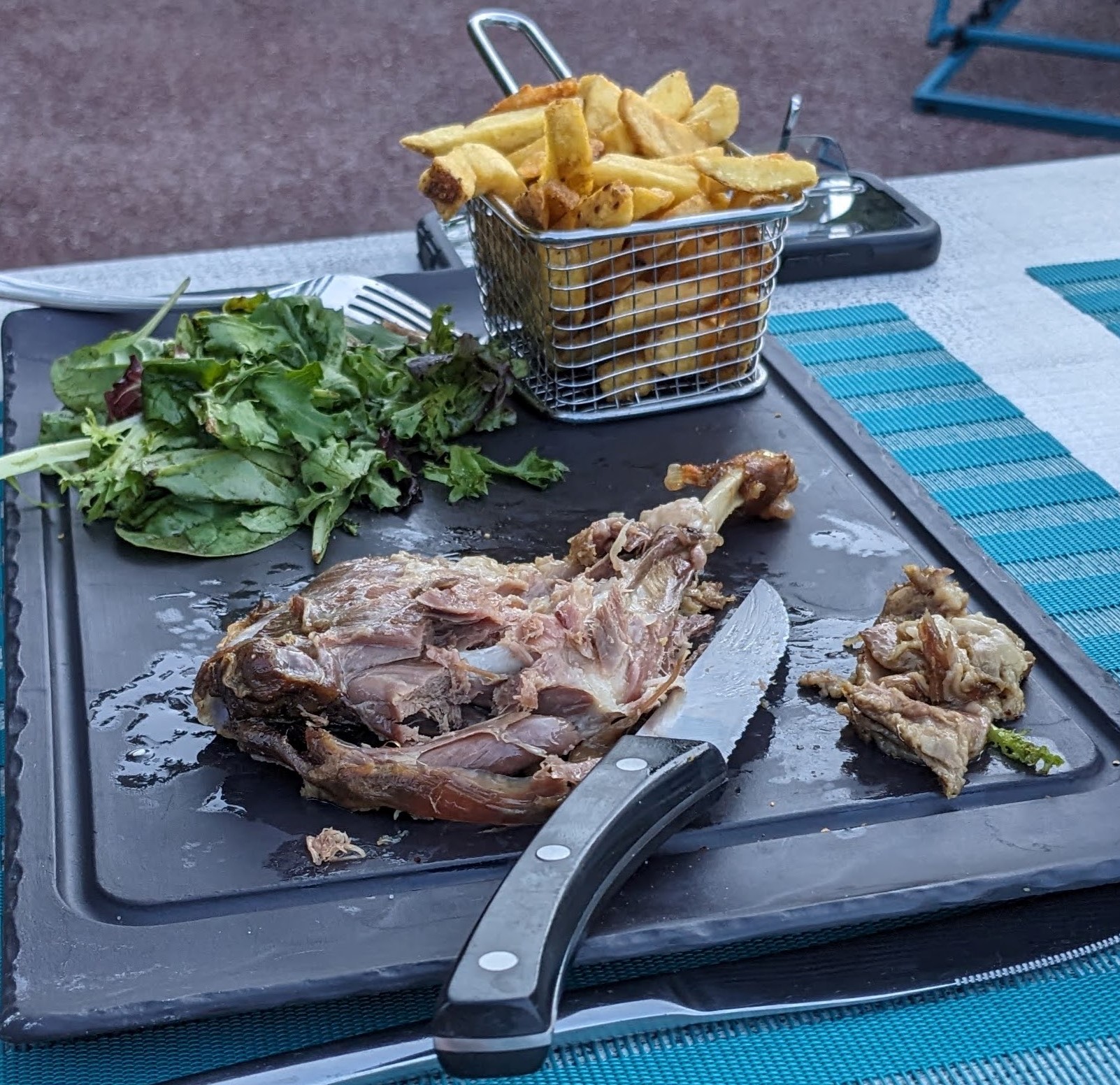
Leg of duck with frites
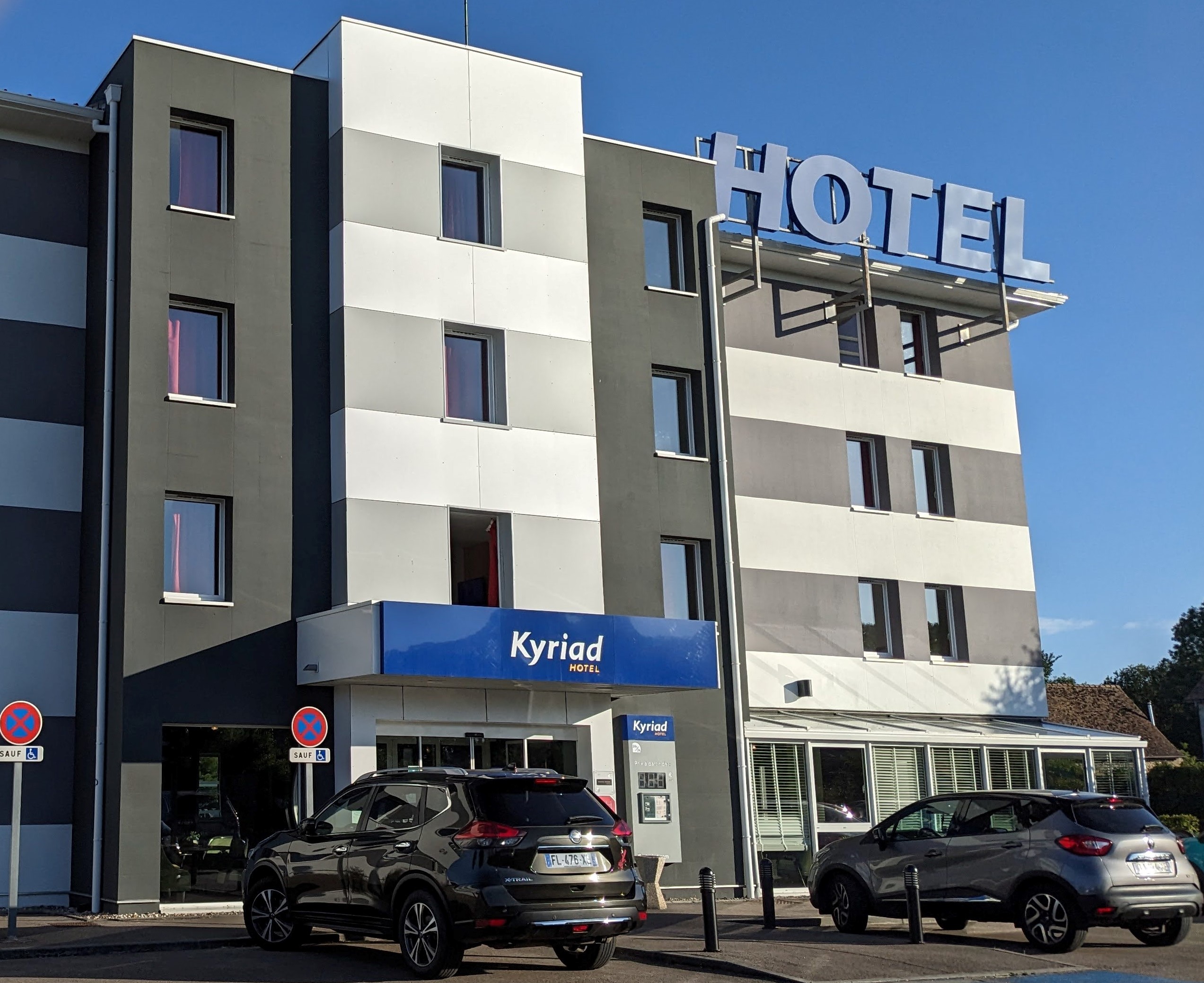
Hotel de Kyriad Val-de-Rueil

Michael unsuccessfully trying to catch up on email
Michael had inadvertently left his washcloth behind at some earlier lodging, so after dinner he dropped Nancy and Pat at the hotel and drove to a department store to buy one. (Michael prefers bar soap on a cloth over shower gel on a puff. Most European hotels do not provide washcloths even if you ask, so he always carries his own.) When he got back with a pair of nice terrycloth mitts, both he and Nancy tried to catch up on their email but the hotel’s Internet was too flaky, so we gave up and went to bed.
How wonderful that you got to see both the Bayeux and Apocalypse tapestries!
I also found the graves of the unknown soldiers at the American Cemetery to be most touching. And was grateful to know that God notes the fall even of a sparrow, much less these brave–or frightened–or both–young men. I was also interested to see the graves of a handful of women in the cemetery and wondered what their stories were.
I enjoy reading about your adventures and your meals!